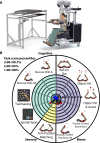Robotic exoskeleton assessment of transient ischemic attack
- PMID: 29272289
- PMCID: PMC5741219
- DOI: 10.1371/journal.pone.0188786
Robotic exoskeleton assessment of transient ischemic attack
Abstract
We used a robotic exoskeleton to quantify specific patterns of abnormal upper limb motor behaviour in people who have had transient ischemic attack (TIA). A cohort of people with TIA was recruited within two weeks of symptom onset. All individuals completed a robotic-based assessment of 8 behavioural tasks related to upper limb motor and proprioceptive function, as well as cognitive function. Robotic task performance was compared to a large cohort of controls without neurological impairments corrected for the influence of age. Impairment in people with TIA was defined as performance below the 5th percentile of controls. Participants with TIA were also assessed with the National Institutes of Health Stroke Scale (NIHSS) score, Chedoke-McMaster Stroke Assessment (CMSA) of the arm, the Behavioural Inattention Test (BIT), the Purdue pegboard test (PPB), and the Montreal Cognitive Assessment (MoCA). Age-related white matter change (ARWMC), prior infarction and cella-media index (CMI) were assessed from baseline CT scan that was performed within 24 hours of TIA. Acute infarction was assessed from diffusion-weighted imaging in a subset of people with TIA. Twenty-two people with TIA were assessed. Robotic assessment showed impaired upper limb motor function in 7/22 people with TIA patients and upper limb sensory impairment in 4/22 individuals. Cognitive tasks involving robotic assessment of the upper limb were completed in 13 participants, of whom 8 (61.5%) showed significant impairment. Abnormal performance in the CMSA arm inventory was present in 12/22 (54.5%) participants. ARWMC was 11.8 ± 6.4 and CMI was 5.4 ± 1.5. DWI was positive in 0 participants. Quantitative robotic assessment showed that people who have had a TIA display a spectrum of upper limb motor and sensory performance deficits as well as cognitive function deficits despite resolution of symptoms and no evidence of tissue infarction.
Conflict of interest statement
Figures


Similar articles
-
Quantifying changes over 1 year in motor and cognitive skill after transient ischemic attack (TIA) using robotics.Sci Rep. 2021 Aug 23;11(1):17011. doi: 10.1038/s41598-021-96177-y. Sci Rep. 2021. PMID: 34426586 Free PMC article.
-
The feasibility of using robotic technology to quantify sensory, motor, and cognitive impairments associated with ALS.Amyotroph Lateral Scler Frontotemporal Degener. 2019 Feb;20(1-2):43-52. doi: 10.1080/21678421.2018.1550515. Epub 2019 Jan 27. Amyotroph Lateral Scler Frontotemporal Degener. 2019. PMID: 30688092
-
Relative independence of upper limb position sense and reaching in children with hemiparetic perinatal stroke.J Neuroeng Rehabil. 2021 May 12;18(1):80. doi: 10.1186/s12984-021-00869-5. J Neuroeng Rehabil. 2021. PMID: 33980254 Free PMC article.
-
Preventing strokes: the assessment and management of people with transient ischaemic attack.N Z Med J. 2009 Apr 24;122(1293):3556. N Z Med J. 2009. PMID: 19448791 Review.
-
Symptoms of transient ischemic attack.Front Neurol Neurosci. 2014;33:82-102. doi: 10.1159/000351905. Epub 2013 Oct 11. Front Neurol Neurosci. 2014. PMID: 24157558 Review.
Cited by
-
Proprioception and motor performance after stroke: An examination of diffusion properties in sensory and motor pathways.Hum Brain Mapp. 2019 Jul;40(10):2995-3009. doi: 10.1002/hbm.24574. Epub 2019 Mar 19. Hum Brain Mapp. 2019. PMID: 30891844 Free PMC article.
-
Task-residual effective connectivity of motor network in transient ischemic attack.Commun Biol. 2023 Aug 14;6(1):843. doi: 10.1038/s42003-023-05212-3. Commun Biol. 2023. PMID: 37580508 Free PMC article.
-
Principal Components Analysis Using Data Collected From Healthy Individuals on Two Robotic Assessment Platforms Yields Similar Behavioral Patterns.Front Hum Neurosci. 2021 May 6;15:652201. doi: 10.3389/fnhum.2021.652201. eCollection 2021. Front Hum Neurosci. 2021. PMID: 34025375 Free PMC article.
-
High intra-task and low inter-task correlations of motor skills in humans creates an individualized behavioural pattern.Sci Rep. 2022 Nov 23;12(1):20156. doi: 10.1038/s41598-022-24479-w. Sci Rep. 2022. PMID: 36418339 Free PMC article.
-
Reverse Visually Guided Reaching in Patients with Parkinson's Disease.Parkinsons Dis. 2022 Mar 28;2022:8132923. doi: 10.1155/2022/8132923. eCollection 2022. Parkinsons Dis. 2022. PMID: 35386952 Free PMC article.
References
-
- Coutts SB, Modi J, Patel SK, Aram H, Demchuk AM, Goyal M, & Hill MD. What causes disability after transient ischemic attack and minor stroke?: Results from the CT and MRI in the triage of TIA and minor cerebrovascular events to identify high risk patients (CATCH) study. Stroke. 2012; 43(11): 3018–3022. doi: 10.1161/STROKEAHA.112.665141 - DOI - PubMed
-
- Pendlebury ST, Wadling S, Silver LE, Mehta Z, & Rothwell PM. Transient cognitive impairment in TIA and minor stroke. Stroke. 2011;, 42(11): 3116–3121. doi: 10.1161/STROKEAHA.111.621490 - DOI - PubMed
-
- Van Rooij FG, Schaapsmeerders P, Maaijwee NAM, Van Duijnhoven DAHJ, De Leeuw FE, Kessels RPC, & Van Dijk EJ. Persistent cognitive impairment after transient ischemic attack. Stroke. 2014; 45(8); 2270–2274. doi: 10.1161/STROKEAHA.114.005205 - DOI - PubMed
-
- Van Der Flier WM, Van Straaten ECW, Barkhof F, Verdelho A, Madureira S, Pantoni L et al. Small vessel disease and general cognitive function in nondisabled elderly: The LADIS study. Stroke. 2005; 36(10): 2116–2120. doi: 10.1161/01.STR.0000179092.59909.42 - DOI - PubMed
-
- Bourke TC, Lowrey CR, Dukelow SP, Bagg SD, Norman KE, & Scott SH. A robot-based behavioural task to quantify impairments in rapid motor decisions and actions after stroke. Journal of NeuroEngineering and Rehabilitation. 2016; 13(1): 91 doi: 10.1186/s12984-016-0201-2 - DOI - PMC - PubMed
Publication types
MeSH terms
LinkOut - more resources
Full Text Sources
Other Literature Sources
Medical

